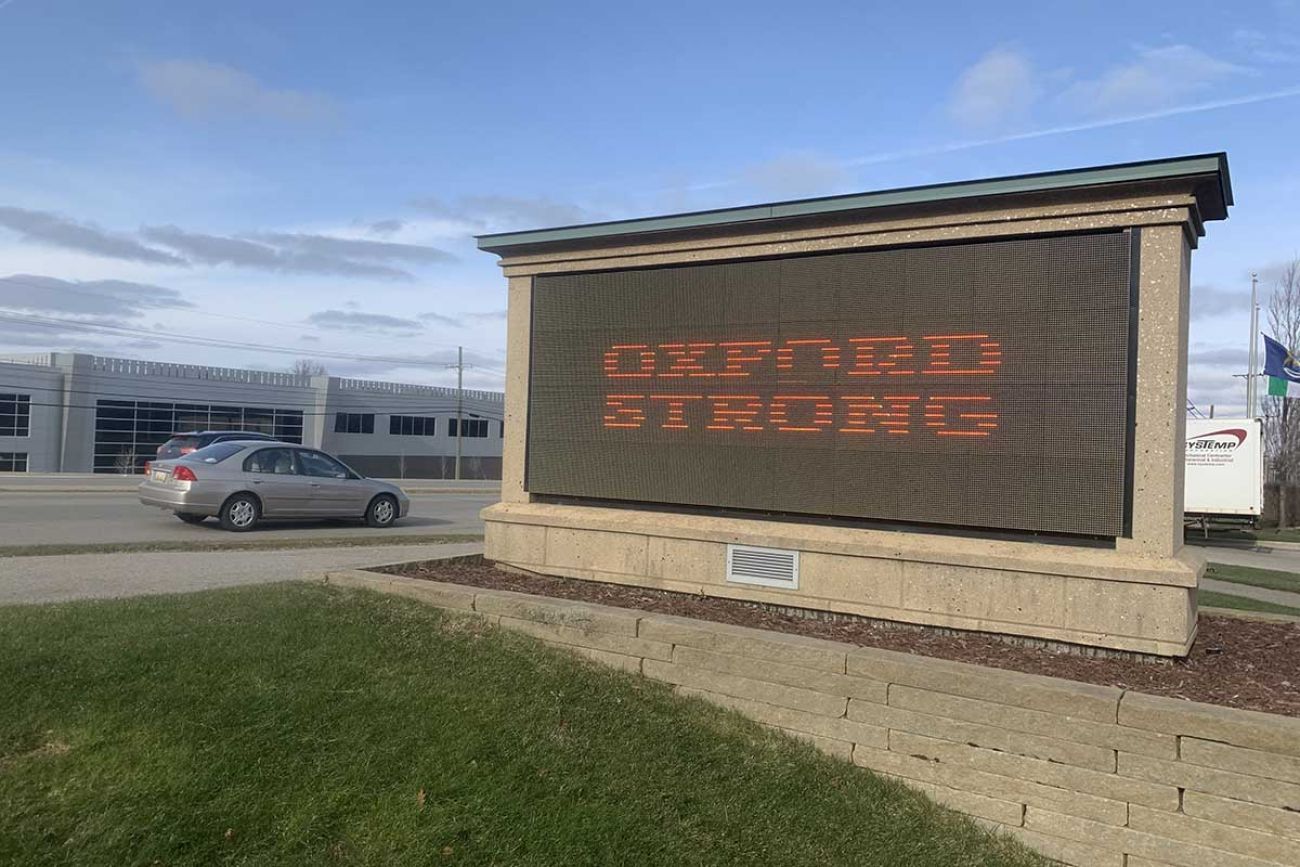Oxford High School tests AI gun detection system in wake of shooting

May 25: Michigan hasn’t passed bills to make schools safer, even after Oxford shooting
Six months after the deadly shooting at Oxford High School that resulted in four student deaths and eight injuries, the school district is experimenting with a new technology to detect guns with the help of artificial intelligence.
The security enhancement is a part of a free, year-long pilot program with ZeroEyes, a tech security company, using artificial intelligence technology to identify guns that can be seen on security cameras, and alert police and security guards of potential threats.
After the artificial intelligence software program identifies a gun, an alert is immediately sent to a team of ZeroEyes employees who determine whether the gun is real. If they confirm there is a threat, a text notification is sent to the school’s security officials and local law enforcement in three to five seconds, according to the company.
Related:
- Michigan school safety task force prioritizes mental health, building security
- Oxford High students push gun reforms in Michigan: ‘Things need to change’
- School violence is rising. Michigan’s OK2SAY tipline can help
In the pilot phase of the program, the system will only monitor cameras at Oxford High School. The school currently has more than 100 cameras, according to Jill Lemond, assistant superintendent of safety and operations for Oxford, and all of them have been synced with the artificial intelligence.
Students aren’t likely to notice the security enhancement. Oxford began trainings for the system in March and it has been in operation since April 13, according to Lemond.
Ethan Crumbley is charged with multiple counts of first-degree murder and other charges in connection with the Nov. 30 shooting. On security footage, Crumbley, 15, can be seen walking the school hallways shooting at students for four to five minutes. He fired more than 30 shots, according to police.
The new system wouldn’t have prevented the shootings; police believe the alleged assailant had a gun hidden in his backpack, and the AI system can only recognize guns that can be seen on camera.
The goal of the system isn’t prevention, but to more quickly alert authorities of danger in order to limit casualties.
Just how much quicker that notification would be made isn’t clear. Police began receiving calls about the Oxford shooting from those in the building within a minute of when shots began being fired, compared to the security company’s estimate of notifying police within 5 seconds.
That’s a small savings in time, but seconds count during a mass shooting.
Oxford started working with ZeroEyes as the district looked for innovative solutions to bolster its existing security protocols. The school district received the software for free and has access to the system through the duration of the 2022-23 school year.
The program was recommended to the school district after the security firm Secure Education Consultants recommended a weapon detection system in its March 2022 report of Oxford safety measures.
“We have always paid great attention to safety. This isn’t a new thing since Nov. 30,” Lemond said. “We’re just looking at even more – even better – solutions.”
Lemond said the district came to the decision to work with ZeroEyes after researching the different options presented to the school district and a survey of students, staff and parents about current safety measures in place.
She said after doing research on multiple companies with weapon recognition software, she appreciated the veteran and law enforcement background workers at ZeroEyes have.
“Number one thing for me is that they have a manned station,” Lemond said. “There is another human element to this, it isn’t just AI, but there is a team of human beings making the decision about whether or not to dispatch law enforcement.”
The program does not use any facial or audio recognition software nor have the ability to identify a concealed weapon.
Previously, cameras were monitored by the school’s security team, which consists of two school resource officers, an armed security guard and a private security firm. The team has an office with monitors that view all cameras, Lemond said.
ZeroEyes was founded by former Navy SEALs and military personnel in 2018 after the school shooting in Parkland, Fla.
The company primarily focuses on K-12 security, but is moving toward having it at more colleges as well, chief operating officer Rob Huberty said. The technology is also in some malls and company headquarters.
Oxford will have to pay for the services if they continue working with ZeroEyes past next school year. Schools of similar size to Oxford High have paid about $15,000 a year for the service, depending on the number of cameras.
Oxford has more than 100 cameras in its high school.
“We’re trying to make this as affordable as we possibly can do,” Huberty said. “We believe it needs to be ubiquitous. It needs to be everywhere, because if it is, we can actually do something.”
Added vice president of marketing Pete Garza, “We are charging for that 24/7/365 service monitoring all their cameras, making sure they’re working properly, and when there’s a gun detection, they get a notification within 3-5 seconds.”
Since the 1999 massacre at Columbine High School that left 13 dead, schools across the country have attempted to harden their buildings. Many schools now keep doors locked, with visitors required to be buzzed in. Students in all grades go through active shooter drills, and classrooms often have devices that can prevent entry.
Still, in the 23 years since Columbine, there have been 304 shootings in U.S. schools.
The announcement of the partnership came the same week the families of two victims of the Oxford shootings, Justin Shilling and Tate Myre, along with the families of four surviving students, filed a federal lawsuit against the school district, saying Oxford officials could have done more to prevent the school shootings. This lawsuit is the second against the school district since the shootings, although additional lawsuits have been directed at individual Oxford officials.
Justin Heinze, an assistant professor of Health Behavior at the University of Michigan and a part of the University’s National Center for School Safety (NCSS), said gun identification technology could help speed up response times during a crisis, but said the system has limitations because it does not serve as an active deterrent to school threats and their main causes.
He said that ‘upstream-related efforts’ that identify characteristics of a possible suspect to prevent a tragedy such as having strong mental health resources, ways for students to report possible threats and teachers being informed of signs, should be used in conjunction with the software to ensure the school is actively trying to prevent incidents rather than just responding quickly to them.
Heinze also said Oxford should have a plan in place in case the ZeroEyes program does detect a tangible threat and communicate with law enforcement to deal with the ripple effects through the school community.
“It might be simple to say, 'yes, we're applying a software that will allow us to identify when a weapon is coming to school,'” Heinze said. “But at the same time, there's a lot about the school culture, a lot about the learning environment that needs to be brought into consideration following the implementation.”
Michigan Education Watch
Michigan Education Watch is made possible by generous financial support from:
Subscribe to Michigan Health Watch
See what new members are saying about why they donated to Bridge Michigan:
- “In order for this information to be accurate and unbiased it must be underwritten by its readers, not by special interests.” - Larry S.
- “Not many other media sources report on the topics Bridge does.” - Susan B.
- “Your journalism is outstanding and rare these days.” - Mark S.
If you want to ensure the future of nonpartisan, nonprofit Michigan journalism, please become a member today. You, too, will be asked why you donated and maybe we'll feature your quote next time!





